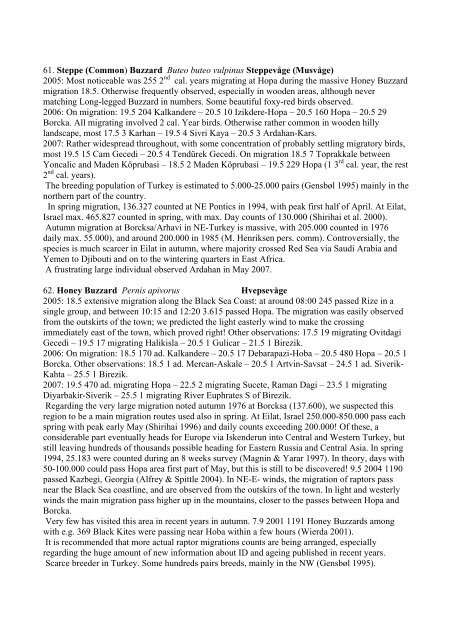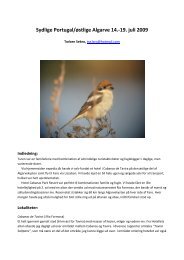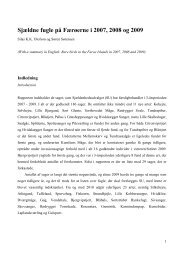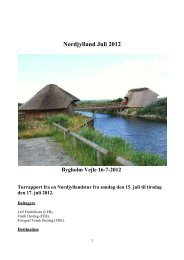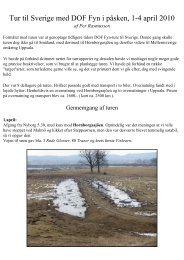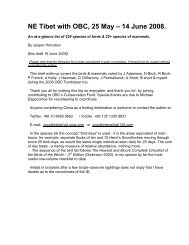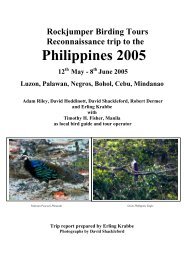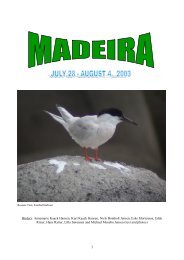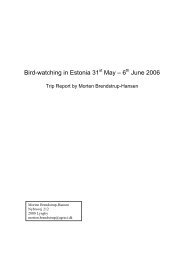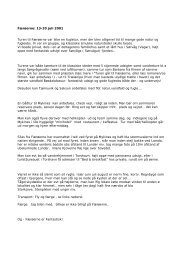TURKEY - a report from a birdwatching trip to Central ... - Netfugl.dk
TURKEY - a report from a birdwatching trip to Central ... - Netfugl.dk
TURKEY - a report from a birdwatching trip to Central ... - Netfugl.dk
Create successful ePaper yourself
Turn your PDF publications into a flip-book with our unique Google optimized e-Paper software.
61. Steppe (Common) Buzzard Buteo buteo vulpinus Steppevåge (Musvåge)<br />
2005: Most noticeable was 255 2 nd cal. years migrating at Hopa during the massive Honey Buzzard<br />
migration 18.5. Otherwise frequently observed, especially in wooden areas, although never<br />
matching Long-legged Buzzard in numbers. Some beautiful foxy-red birds observed.<br />
2006: On migration: 19.5 204 Kalkandere – 20.5 10 Izikdere-Hopa – 20.5 160 Hopa – 20.5 29<br />
Borcka. All migrating involved 2 cal. Year birds. Otherwise rather common in wooden hilly<br />
landscape, most 17.5 3 Karhan – 19.5 4 Sivri Kaya – 20.5 3 Ardahan-Kars.<br />
2007: Rather widespread throughout, with some concentration of probably settling migra<strong>to</strong>ry birds,<br />
most 19.5 15 Cam Gecedi – 20.5 4 Tendürek Gecedi. On migration 18.5 7 Toprakkale between<br />
Yoncalic and Maden Köprubasi – 18.5 2 Maden Köprubasi – 19.5 229 Hopa (1 3 rd cal. year, the rest<br />
2 nd cal. years).<br />
The breeding population of Turkey is estimated <strong>to</strong> 5.000-25.000 pairs (Gensbøl 1995) mainly in the<br />
northern part of the country.<br />
In spring migration, 136.327 counted at NE Pontics in 1994, with peak first half of April. At Eilat,<br />
Israel max. 465.827 counted in spring, with max. Day counts of 130.000 (Shirihai et al. 2000).<br />
Autumn migration at Borcksa/Arhavi in NE-Turkey is massive, with 205.000 counted in 1976<br />
daily max. 55.000), and around 200.000 in 1985 (M. Henriksen pers. comm). Controversially, the<br />
species is much scarcer in Eilat in autumn, where majority crossed Red Sea via Saudi Arabia and<br />
Yemen <strong>to</strong> Djibouti and on <strong>to</strong> the wintering quarters in East Africa.<br />
A frustrating large individual observed Ardahan in May 2007.<br />
62. Honey Buzzard Pernis apivorus Hvepsevåge<br />
2005: 18.5 extensive migration along the Black Sea Coast: at around 08:00 245 passed Rize in a<br />
single group, and between 10:15 and 12:20 3.615 passed Hopa. The migration was easily observed<br />
<strong>from</strong> the outskirts of the <strong>to</strong>wn; we predicted the light easterly wind <strong>to</strong> make the crossing<br />
immediately east of the <strong>to</strong>wn, which proved right! Other observations: 17.5 19 migrating Ovitdagi<br />
Gecedi – 19.5 17 migrating Halikisla – 20.5 1 Gulicar – 21.5 1 Birezik.<br />
2006: On migration: 18.5 170 ad. Kalkandere – 20.5 17 Debarapazi-Hoba – 20.5 480 Hopa – 20.5 1<br />
Borcka. Other observations: 18.5 1 ad. Mercan-Askale – 20.5 1 Artvin-Savsat – 24.5 1 ad. Siverik-<br />
Kahta – 25.5 1 Birezik.<br />
2007: 19.5 470 ad. migrating Hopa – 22.5 2 migrating Sucete, Raman Dagi – 23.5 1 migrating<br />
Diyarbakir-Siverik – 25.5 1 migrating River Euphrates S of Birezik.<br />
Regarding the very large migration noted autumn 1976 at Borcksa (137.600), we suspected this<br />
region <strong>to</strong> be a main migration routes used also in spring. At Eilat, Israel 250.000-850.000 pass each<br />
spring with peak early May (Shirihai 1996) and daily counts exceeding 200.000! Of these, a<br />
considerable part eventually heads for Europe via Iskenderun in<strong>to</strong> <strong>Central</strong> and Western Turkey, but<br />
still leaving hundreds of thousands possible heading for Eastern Russia and <strong>Central</strong> Asia. In spring<br />
1994, 25.183 were counted during an 8 weeks survey (Magnin & Yarar 1997). In theory, days with<br />
50-100.000 could pass Hopa area first part of May, but this is still <strong>to</strong> be discovered! 9.5 2004 1190<br />
passed Kazbegi, Georgia (Alfrey & Spittle 2004). In NE-E- winds, the migration of rap<strong>to</strong>rs pass<br />
near the Black Sea coastline, and are observed <strong>from</strong> the outskirs of the <strong>to</strong>wn. In light and westerly<br />
winds the main migration pass higher up in the mountains, closer <strong>to</strong> the passes between Hopa and<br />
Borcka.<br />
Very few has visited this area in recent years in autumn. 7.9 2001 1191 Honey Buzzards among<br />
with e.g. 369 Black Kites were passing near Hoba within a few hours (Wierda 2001).<br />
It is recommended that more actual rap<strong>to</strong>r migrations counts are being arranged, especially<br />
regarding the huge amount of new information about ID and ageing published in recent years.<br />
Scarce breeder in Turkey. Some hundreds pairs breeds, mainly in the NW (Gensbøl 1995).


